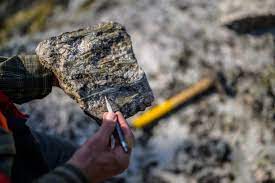Energy & Critical Metals
OCSiAl launching two new high concentrated graphene nanotube dispersions for anodes and cathodes
OCSiAl, a leader in graphene nanotube (single wall carbon nanotube or SWCNT) technology and manufacturing, has expanded its product line for Li-ion batteries…

OCSiAl, a leader in graphene nanotube (single wall carbon nanotube or SWCNT) technology and manufacturing, has expanded its product line for Li-ion batteries with two highly concentrated nanotube dispersions for anodes and cathodes.
The new products offer improved cost-efficiency, allow for more sustainable manufacturing, and offer superior performance for batteries over standard solutions, such as multi-wall carbon nanotubes (MWCNTs) or carbon black, which require at least a 10 times higher concentration in the electrode compared to SWCNTs, according to OCSiAl.
Electrode sample with 0.06% of SWCNTs shows good coverage of the particle’s surface. Source: OCSiAl.
Compared to short, rigid MWCNTs or carbon black, SWCNTs create robust, long electrical networks between active material particles, improving key battery characteristics, including cycle life, DCR, c-rate performance, and cohesion. This is especially important in systems that tend to suffer from high volume expansion, such as silicon-containing anodes. In such anodes, OCSiAl’s nanotubes significantly reduce the degradation problem and unlock industrial-scale use of silicon, the highest-capacity active material for anodes.
In modern, promising LFP and NCM cathode materials, graphene nanotubes make it possible to create thick electrodes with stable mechanical characteristics thanks to improved cohesion.
A new product line, 1% TUBALL BATT NMP for cathodes and 0.8% TUBALL BATT H2O for anodes, allows producers to improve battery performance even further. The advantages of these new dispersions stem from the high content of graphene nanotubes, which is 2–2.5 times higher than in the current products.
These graphene nanotube concentrations represent the leading values in the industry among all serially produced SWCNT-based dispersions. To introduce the same number of nanotubes into the electrode, less solvent is now used, and thus battery manufacturers can achieve a higher solid content in the slurry. Besides that, a highly concentrated form of dispersions is undoubtedly more cost-effective—it allows for a significant cost-of-properties reduction compared to the existing products.
—Andrej Seniut, Head of OCSiAl Energy Projects and Senior Vice President
On top of that, lower material consumption throughout—in dispersion manufacture, transportation, storage, and battery making—reduces logistics costs by 2–2.5 times and significantly contributes to sustainable development.
The new technology has already made it possible to reduce the cost of nanotubes for the battery industry, while we are already developing a future generation of products that, in addition to the many performance benefits, are intended to bring even more cost-competitive advantages compared to multi-wall carbon nanotubes.
—Andrej Seniut

Uranium Exploration Company Announces Additional Staking in the Athabasca Basin
Source: Streetwise Reports 12/22/2023
Skyharbour Resources Ltd. announced an update from its Canada-based Falcon Project along with additional…
Tesla Launches New Mega Factory Project In Shanghai, Designed To Manufacture 10,000 Megapacks Per Year
Tesla Launches New Mega Factory Project In Shanghai, Designed To Manufacture 10,000 Megapacks Per Year
Tesla has launched a new mega factory…
Giving thanks and taking stock after “a remarkable year”
An end-of-year thank you to our readers, industry colleagues and advertisers before Electric Autonomy breaks from publishing until Jan. 2
The post Giving…

















